Institutional constituents hope to see improved efficiency and support for users across campus from the use of AI tools in communications applications.

EDUCAUSE and Zoom, a 2024 EDUCAUSE Mission Partner, collaborated to identify the topic for this QuickPoll, formulate and evaluate the research objectives, and develop the poll questions.
EDUCAUSE is helping institutional leaders, IT professionals, and other staff address their pressing challenges by sharing existing data and gathering new data from the higher education community. This report is based on an EDUCAUSE QuickPoll. QuickPolls enable us to rapidly gather, analyze, and share input from our community about specific emerging topics.Footnote1
For the purposes of this QuickPoll, we offer the following definitions:
- Artificial intelligence (AI): We use the definition of AI established by the U.S. National Artificial Intelligence Act of 2020: "A machine-based system that can, for a given set of human-defined objectives, make predictions, recommendations or decisions influencing real or virtual environments." Please note that this definition includes, but is not limited to, generative AI.
- Communication applications: The variety of tools used for communication across campus (videoconferencing, voice over IP phone service, instant messaging, chatbots, etc.).
The Challenge
As the recently published EDUCAUSE Top 10 indicates, college and university officials are looking for ways to simplify administrative tasks as well as smooth the student journey. Educators and students are looking to AI to help with these tasks, and integrating AI tools in communication applications presents both opportunities and challenges that need to be carefully navigated. AI is already being added to many of these tools, and institutions will have to decide how to prioritize implementing the features available to promote efficiency and productivity for administration, education, and research. Institutions will also have to balance the financial and human-resource costs of using and putting these tools into practice against the potential benefits they can provide. The biases of AI and its technological limitations will require staff and students to keep an eye on the outputs of these tools. Addressing these challenges requires planning, continuous monitoring, and a continued commitment to ethical AI practices in education.
The Bottom Line
Respondents expect AI to improve efficiencies for most groups across institutions, especially by providing summaries and post-meeting suggestions from videoconferencing. Data security and data privacy are the most cited important features when considering the addition of AI tools to communications applications. Respondents are looking to AI to help improve accessibility for users with disabilities, while chatbots present an opportunity for institutions to provide important information to students, faculty, and staff whenever and wherever they are. Respondents reported numerous ways chatbots might be able to help function as personalized tutors, assist with low-level IT help desk issues, and answer questions on admissions, financial aid, institutional policy, and more. Overall, hopes are high that the addition of AI tools to communications applications will improve productivity and experiences for users across campus.
The Data: Use and Efficiency
Most institutions are already using AI in communication tools. A majority of respondents (71%) said their institution is currently using AI tools/features that are included in communications applications (see figure 1). Of the 29% of respondents who didn't know or said that their institution is not currently using AI in these tools, a majority (68%) indicated that their institution is likely to begin using AI in these tools within the next 12 months, with almost a third (31%) saying future use is very likely, and slightly more (37%) saying future use is somewhat likely (see figure 2).

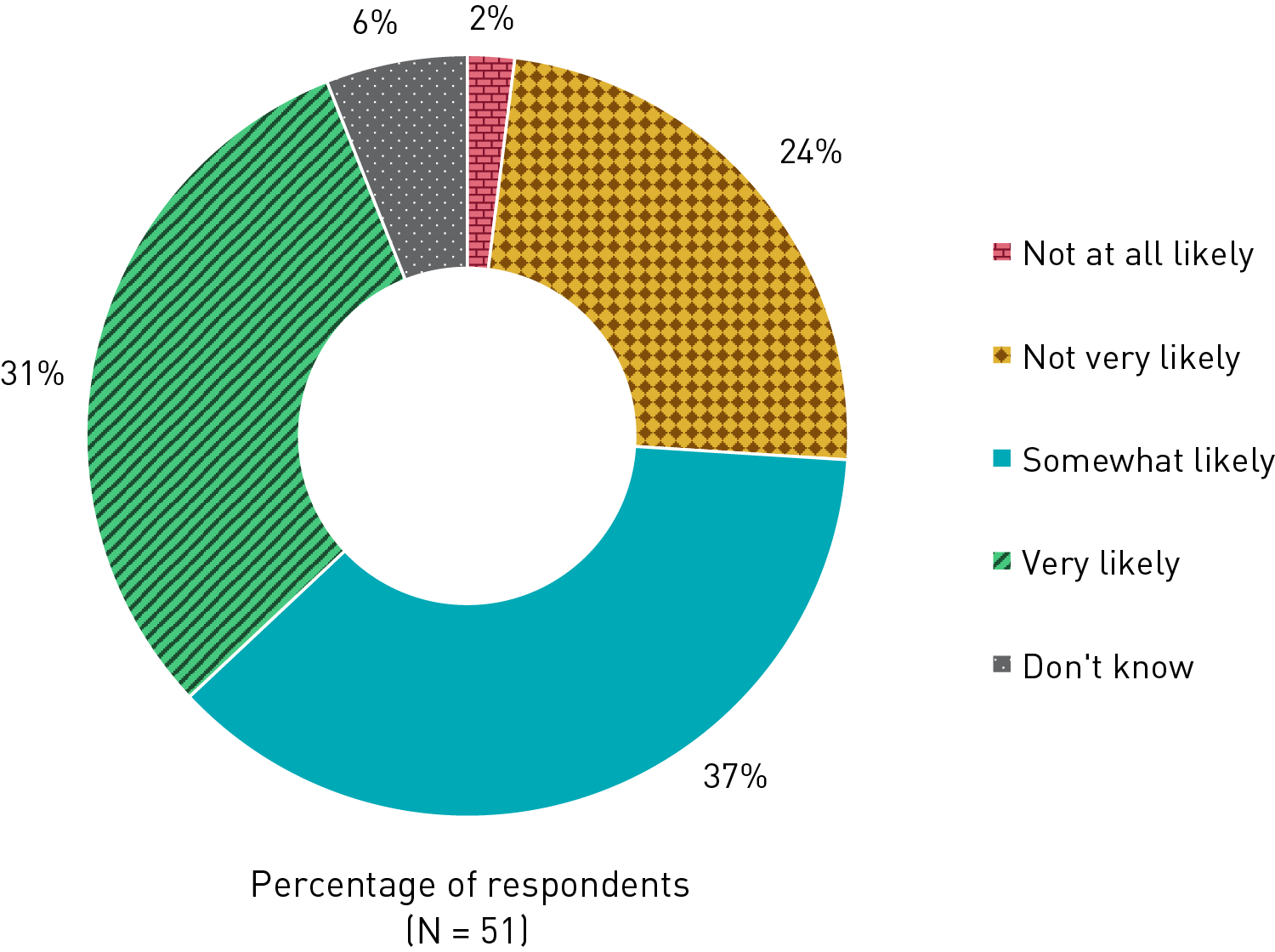
Respondents expect improved efficiency across campus from AI. A majority of respondents said that the use of AI tools in communications applications would lead to some or a lot of improvement in professional or academic efficiency for staff (90%), faculty (85%), students (78%), and researchers (72%) (see figure 3). Interestingly, while respondents anticipate a greater boost in efficiency for staff and faculty members, uncertainty was much higher for researchers and students—these groups had the most "don't know" responses (22% and 13%, respectively).
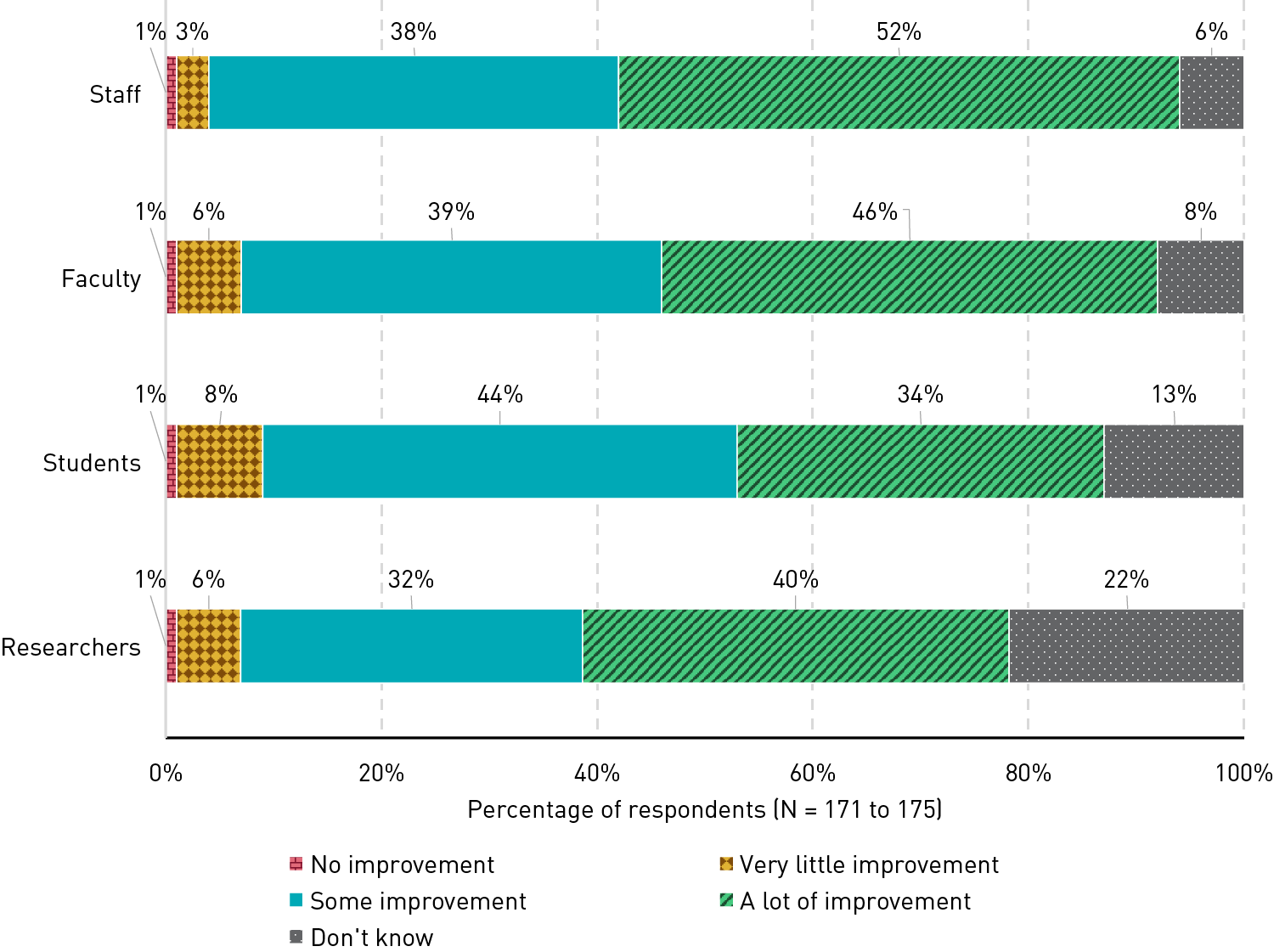
The Data: Important Features and Benefits
Privacy and security are at the forefront. Respondents were asked to select features that are important for them when considering AI tools and capabilities in communication applications. The two highest-ranked features were data privacy and data security (76% and 75% of respondents, respectively; see figure 4). This result is not surprising, given other EDUCAUSE research indicating that data privacy and security are among the leading factors driving institutions' selection of third-party services and providers.Footnote2 It is also worth noting that although accessibility ranked mid-pack on the list of features (selected by 56% of respondents), upcoming regulations under Title II of the Americans with Disabilities Act might make the accessibility of AI tools a more pressing issue in the near future.Footnote3
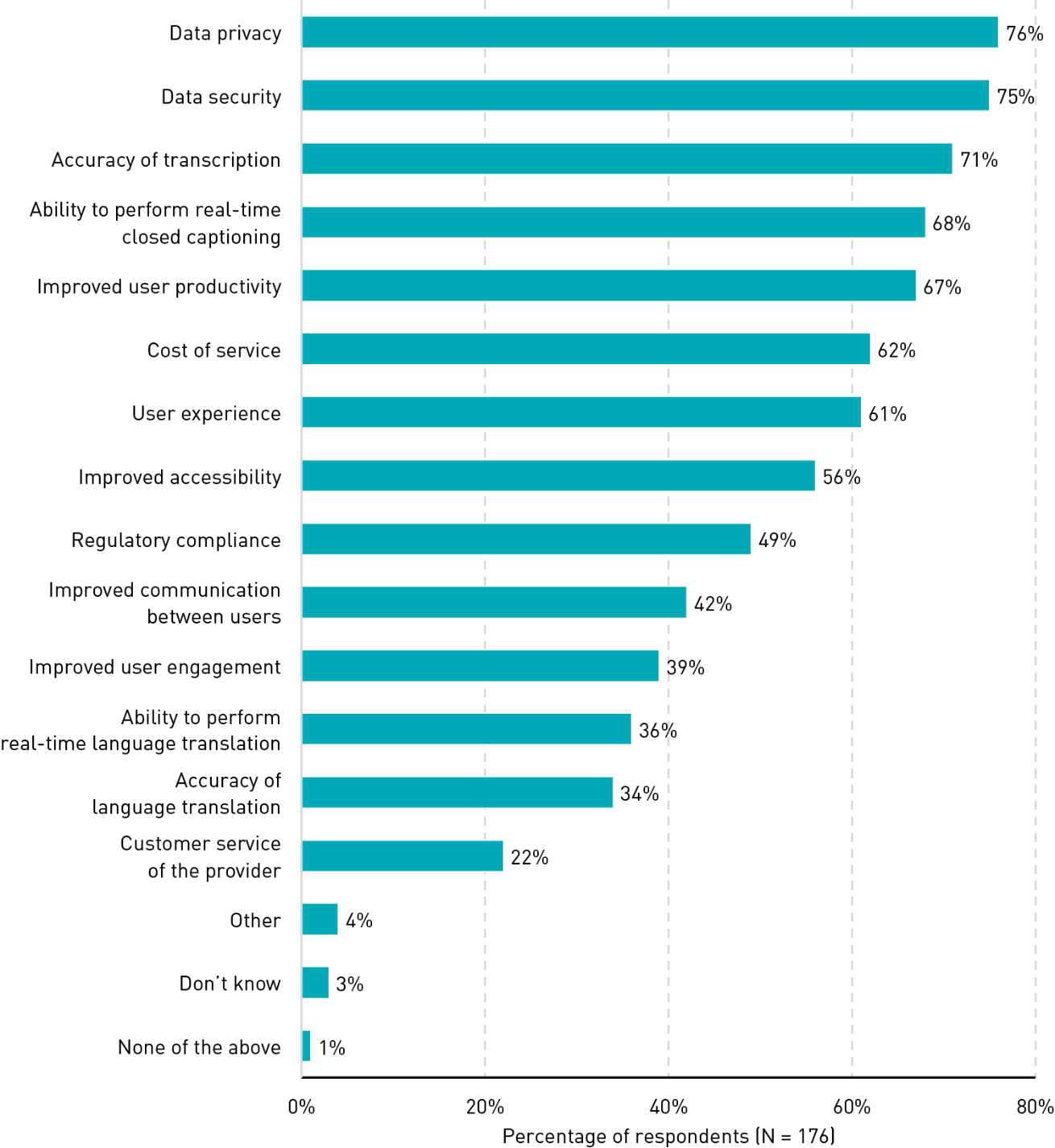
Respondents expect to see the most benefits for staff and faculty. The adoption of AI-powered technologies in communications applications could lead to a wide range of benefits. The two most-selected benefits were related to staff and faculty use: summaries of videoconferencing meetings and suggestions for next steps after meetings (79% and 60%, respectively; see figure 5). Student-related benefits related to videoconferencing ranked third and fourth, selected by 55% and 49% of respondents, respectively. This ranking aligns with the finding that respondents believe staff and faculty are the stakeholders who stand to see the most improvement in their efficiency by using AI (see figure 3). Overall, this gap in interest between staff/faculty and student use could be due to differences in goals (i.e., educators might prefer that students generate their own summaries and action plans) or differences in risk (i.e., educators might be more concerned about privacy and security for student data). Voice and sentiment analysis ranked lowest on the list, selected by just 11% of respondents, possibly related to the higher education community's concerns about AI being used to simulate human judgment.Footnote4
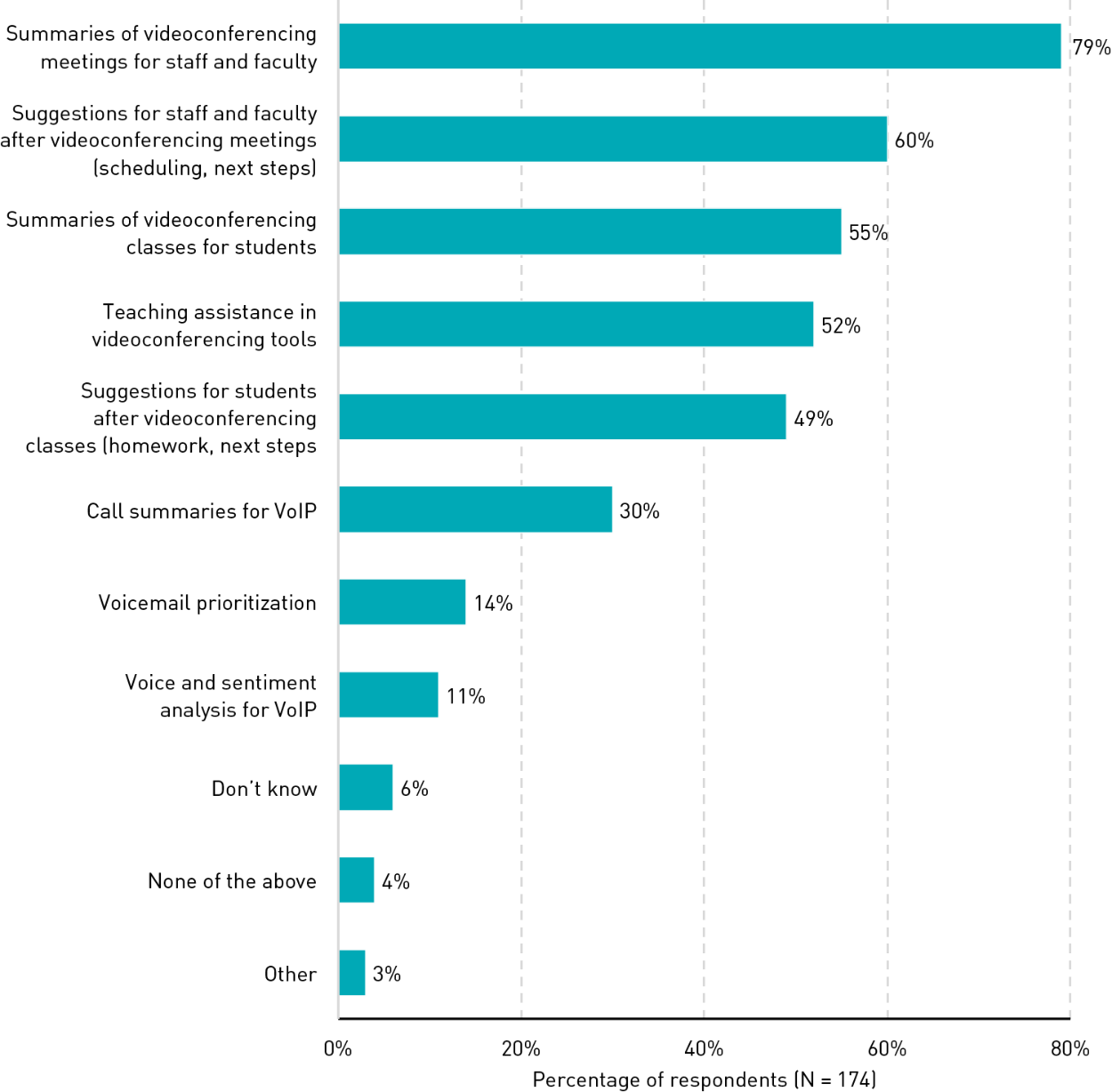
The Data: Chatbots
Respondents see use cases for chatbots, but their trust only goes so far. Asked in an open-ended question to describe use cases for chatbots that would be helpful, respondents most commonly highlighted low-level, frontline web tasks and inquiries for which chatbots could provide basic information and guidance (see figure 6). This might include information about the institution for prospective students; directing web users to the relevant pages, persons, or departments they're searching for; information on institutional policies; or tier-1 help desk inquiries from students or faculty.
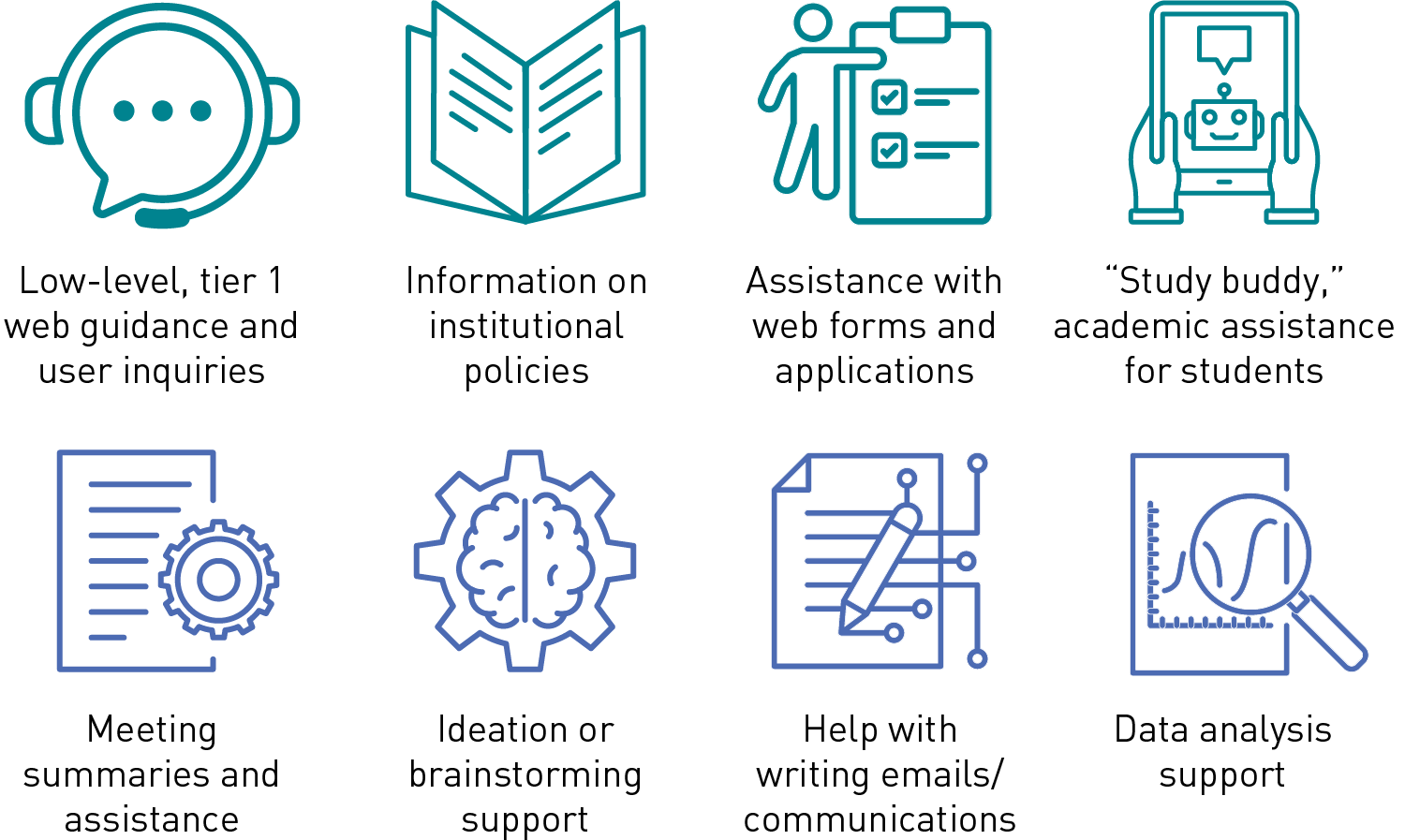
Some respondents did highlight more advanced chatbot uses, potentially elevating chatbots to the role of an "assistant" engaged in more meaningful activities. This could include using chatbots as "study buddies" that provide students with academic assistance and personalized "nudges" for their coursework; engaging with chatbots as ideation partners in thinking through project plans or course design; getting help in writing emails and other communications; and summarizing meetings and other data inputs.
For many institutional leaders and staff, however, the jury may simply still be out on whether and how chatbots can make meaningful contributions to the institution's work. Only 19% of respondents, for example, reported being very comfortable with chatbots handling student service inquiries (see figure 7). As one respondent observed, "No so-called 'AI' would ever replace one-to-one communication. Personal one-to-one communication is part of our institutional identity and one of our institutional strengths."
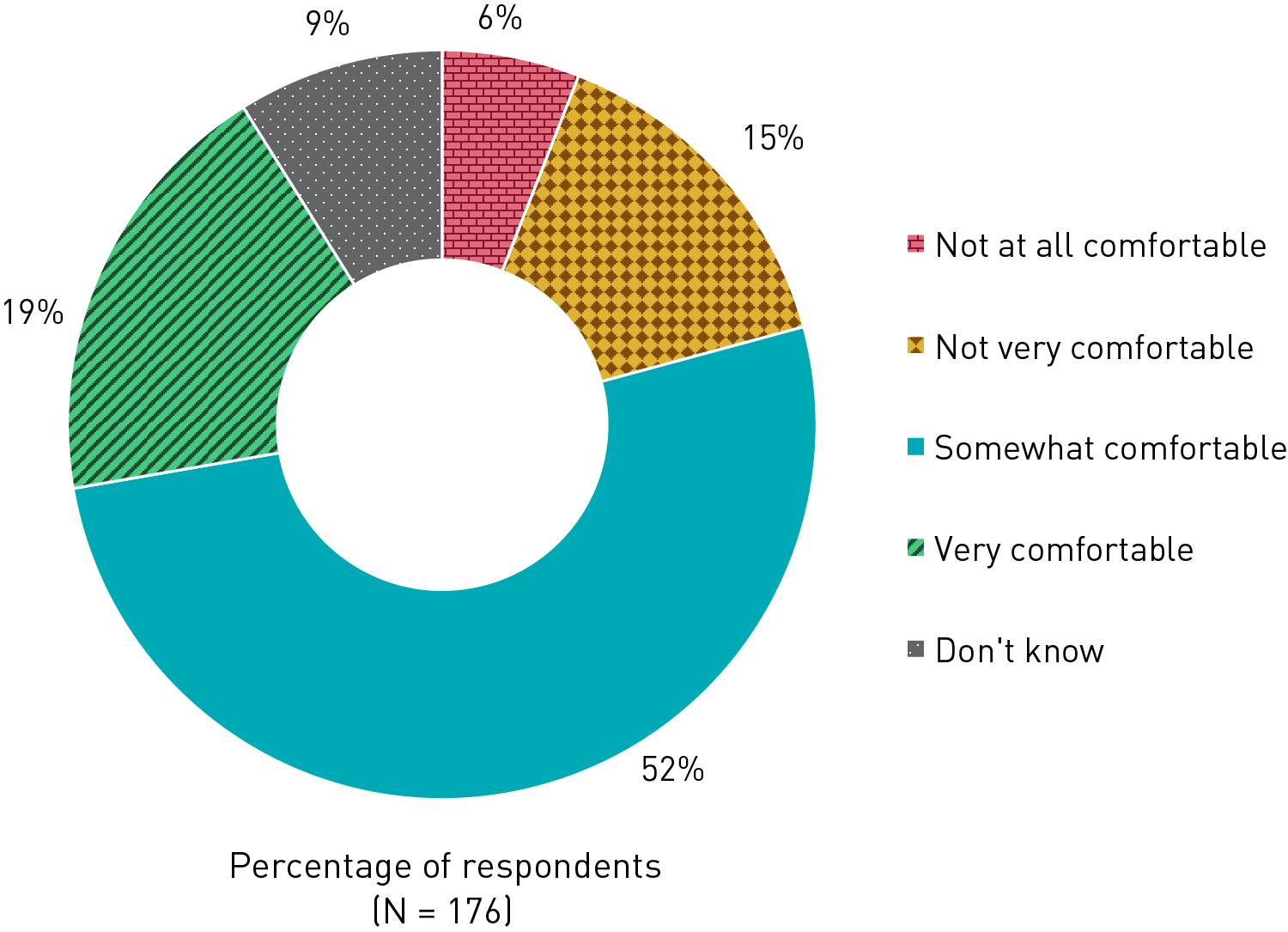
Promising Practices
How AI can better serve the needs of students. Respondents were asked how AI in communication applications can better serve students. In open-ended responses, several promising areas of use/support were identified:
- Simple academic tasks such as outlining, grammar correction, and translation
- Accessibility and inclusivity through functions such as more accurate captioning and descriptive audio, more on-demand tools for students with disabilities, and time management assistance
- Personalization and flexibility through 24/7 access to chatbots or other AI tools to help plan academic progress and career goals, answer questions, and find resources
- Classroom assistance, including functions such as providing lecture summaries and developing practice study materials
- Helping students who have to go through repetitive or complex admissions or financial aid processes
How AI can better serve the needs of staff, faculty, and researchers. When asked about other groups on campus, the open-ended responses identified more ways AI might serve users:
- Improving clarity and accuracy of notes and communications
- Reducing administrative load by assisting with scheduling, responding to emails, and summarizing meetings and readings
- Helping researchers with academic referencing and citations, as well as with identifying/summarizing relevant research articles
- Answering questions about available services and policies (e.g., HR policies, facilities, campus safety)
- Assisting with project management by keeping track of next steps and tasks
All QuickPoll results can be found on the EDUCAUSE QuickPolls web page. For more information and analysis about higher education IT research and data, please visit the EDUCAUSE Review EDUCAUSE Research Notes topic channel. For information about research standards, including for sponsored research, see the EDUCAUSE Research Policy.
Notes
- QuickPolls are less formal than EDUCAUSE survey research. They gather data in a single day instead of over several weeks and allow timely reporting of current issues. This poll was conducted between November 11 and November 13, 2024, consisted of 15 questions, and resulted in 176 complete responses. The poll was distributed by EDUCAUSE staff to relevant EDUCAUSE Community Groups rather than via our enterprise survey infrastructure, and we are not able to associate responses with specific institutions. Our sample represents a range of institution types and FTE sizes. Jump back to footnote 1 in the text.
- Nicole Muscanell, "EDUCAUSE QuickPoll Results: Third-Party Risk Management Practices in Higher Education," EDUCAUSE Review, August 12, 2024. Jump back to footnote 2 in the text.
- Katie Branson, "Web and Mobile App Accessibility Regulations," EDUCAUSE Review, June 10, 2024. Jump back to footnote 3 in the text.
- Jenay Robert, 2024 EDUCAUSE AI Landscape Study, research report (Boulder, CO: EDUCAUSE, February 2024). Jump back to footnote 4 in the text.
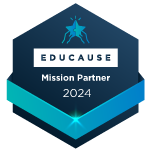 EDUCAUSE Mission Partners
EDUCAUSE Mission Partners
EDUCAUSE Mission Partners collaborate deeply with EDUCAUSE staff and community members on key areas of higher education and technology to help strengthen collaboration and evolve the higher ed technology market. Learn more about Zoom, 2024 EDUCAUSE Mission Partner, and how they're partnering with EDUCAUSE to support your evolving technology needs.
Sean Burns is Corporate Researcher at EDUCAUSE.
© 2024 Sean Burns. The content of this work is licensed under a Creative Commons BY-NC-ND 4.0 International License.
